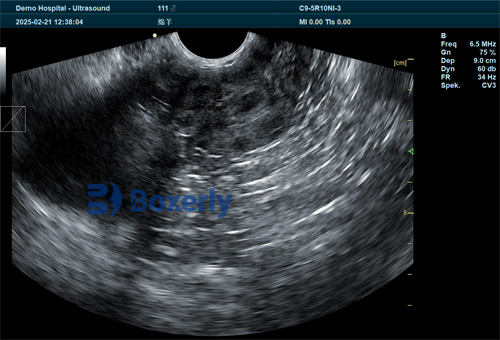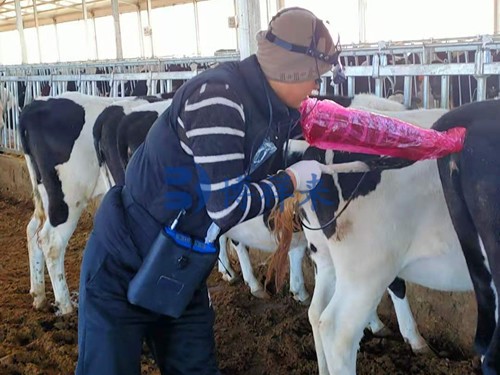As a sheep producer, accurately identifying pregnant ewes early in gestation has become essential for improving flock management, reducing costs, and boosting overall performance. Among the modern tools available, B-mode ultrasonography (hereafter "ultrasound") stands out as a reliable, non‑invasive, and efficient way to determine pregnancy status, litter size, gestational age, and even detect uterine conditions. This article explores how ultrasound is used internationally for early pregnancy detection in sheep, examining its science, practical benefits, and global best practices.

Why Early Pregnancy Detection Matters
Pregnancy confirmation soon after breeding offers several important advantages:
Cull or Remate Nonpregnant Ewes
Identifying open ewes by 35–45 days post‑breeding enables producers to remate them or remove them from the breeding program—saving feed and improving flock reproductive efficiency.Target Nutritional Strategies
Knowing which ewes carry singles, twins, or multiples allows for tailored feeding—supporting fetal growth and preventing metabolic diseases such as pregnancy toxemia.Improve Lamb Survival and Profits
Early grouping facilitates better management do decrease lamb mortality and optimize lambing percentages—translation: more lambs weaned per ewe, increasing profit per head.Detect Reproductive Issues
Ultrasound can spot embryonic failures, uterine fluid like accumulated pus, or early uterine infections—helping decide whether to treat or cull.
These benefits carry significant economic impact. For instance, one Chinese case study showed using ultrasound to identify 2,056 non‑pregnant sheep saved roughly 1.2 million CNY in feed costs.
How Ultrasound Works in Sheep
Portable B-mode ultrasound machines produce two-dimensional grayscale images that display the uterus, fetal vesicles, and viable embryos.
Transrectal vs Transabdominal Scanning
Transrectal scanning (probe inserted into rectum with extension):
Allows detection as early as day 17–21 post‑mating, though experience and high-frequency probes (5–10 MHz) are required.Transabdominal scanning (probe on the abdomen):
Suitable for day 25–45+. Most practical at day 35–45, offering a balance between ease and reliability with pregnancy detection accuracy exceeding 98%.
Optimal Timing
Detection of pregnancy fluid may be possible by day 17–19 (transrectal) and day 25–28 (transabdominal) .
Embryonic heartbeat visible by day 21–23 (rectal) and day 27–30 (abdominal).
General recommendation: scan between 35–45 days post-breeding—this timing achieves high accuracy (>98%) while being simple enough for routine on-farm use.
Accuracy and Limitations
Pregnancy detection accuracy:
• ~85% by day 32; ~98% by day 34 when using transrectal ultrasound.
• Transabdominal accuracy of 99.2% sensitivity and 97.6% specificity between days 29–89.Fetal litter count accuracy:
• 80–90% accurate for single and twin pregnancies. Multiples like triplets are harder to identify.Influencing factors:
• Animal condition (fat, dirty fleece)
• Full rumen
• Operator experience
• Fetal size outside the optimal window (< 55 or > 100 days).

Global Case Studies and Practices
United States (MSU Extension & MSD Vet Manual)
Michigan State University and Merck Veterinary Manual both advocate ultrasound-based pregnancy diagnosis for management improvements:
Early grouping: feed allocation and culling management
Litter size help tailor nutrition, especially during late gestation
Efficiency: experienced operators can scan 100–150 ewes per hour.
Australia and South Africa
On Australian and South African farms, ultrasound pregnancy scanning is routine:
Scans around day 40 post-rams, with repeat at ~80–100 days to count lambs.
Enables re-housing of multiples into higher-quality feed and improved welfare planning.
Producers using electronic ID and ultrasound to segment flocks by pregnancy status/litter size report improved feeding, lamb survival, and financial outcomes.
Middle East: Awassi Ewes
Real-time ultrasound on Awassi sheep has shown:
Accuracy of only ~16.6% at day 15, rising to ~70% by day 25.
By day 35, detection accuracy reached ~90%; by day 50, it was 100% for pregnancy, fetal age, and litter type.
This reinforces the 35–45-day window as optimal globally.
Chinese Farm Outcomes
A large-scale Chinese study applied ultrasound at 35–45 days post-breeding:
Efficiency gain: Pregnant ewes diagnosed and managed early; 2,056 non-pregnant ewes were identified and removed, saving approximately 1.2 million CNY in feed costs.
Health monitoring: Uterine issues (fluid, pus) common with embryo transfers were detected early, enabling timely treatment or culling.
Production model impact: On-farm ultrasound supported industrialized, intensive sheep production—assisting in herd segmentation, replication, and reproductive rate optimization .
Technical Setup and Training
Equipment
Portable B-mode units with 3–5 MHz linear probes are standard for abdominal scanning.
Higher-frequency probes (5–10 MHz) with rectal extensions yield earlier detection but are used less widely.
Devices like BXL’s systems offer high-resolution, portable options suitable for field use.
Procedure
Scan window: Ideally day 35–45 post-breeding.
Animal prep: Keep off feed/water before scanning to empty rumen.
Probe application: Shave or part fleece, apply ultrasound gel to ensure proper contact.
Scan workflow:
Identify fluid pocket and fetal vesicle
Detect heartbeat for confirmation
Count fetus(es) to assess litter size
Check uterus for pathological signs
Sample throughput:
Experienced teams can handle 100–270 ewes per hour.
Training Needs
Operator skill is critical—higher accuracy comes with practice.
On-farm training sessions or partnering with experienced veterinarians pays dividends.
Economic and Welfare Benefits
Feed Economies
By segregating dry, single, and multiple-bearing ewes:
Nonpregnant ewes avoid unnecessary feed.
Nutrient intake matches reproductive demand, improving condition scores and lamb survival rates.
Increased Lamb Outputs
Farms report 10%+ higher lambing rates when grouping and targeted feeding are implemented early.
Reducing lamb mortality even by a few percent can meaningfully enhance revenue.
Health Management
Early detection of uterine infections or fluid preserves ewe health and future fertility.
Enhanced Reproductive Turnover
Identifying empty ewes enables quick rebreeding or culling—sustaining flock productivity and shortening lambing windows .
Scaling the Operation
Ultrasound scans support intensive, industrial sheep farming models practiced worldwide, especially in China and Australia, enhancing standardization and operational scalability.
Limitations and Considerations
Despite strong advantages, ultrasound scanning has limitations:
Skill dependency: Inexperienced operators may miss early pregnancies or underestimate litter size.
Cost: Initial investment in equipment and training may challenge small producers, though ROI is typically positive.
Stress factors: Animals should be calm and handled properly to prevent inaccurate results.
Window sensitivity: Scanning too early (< 25 days) or too late (> 100 days) impairs detection or counting accuracy .
Integration into Flock Management
To maximize benefits, ultrasound-based preg-checking should fit into a broader management protocol:
Synchronize mating/breeding
Scan at 35–45 days post-breeding
Group by status and litter size
Tailor nutrition and health care
Remate or cull nonpregnant ewes promptly
Reassess multiples closer to lambing (80–100 days)
Consistent data collection helps producers measure gains in lambing %, feed efficiency, and downstream lamb performance.

International Perspectives
UK, North America, Australia: Ultrasound is considered standard best practice in meat and commercial flocks.
Middle East: Research validates ultrasound’s reliability by day 35–50.
China: Large operations highlight dramatic feed cost savings and reproductive monitoring innovations .
These global trends illustrate how ultrasound supports both small-scale and industrial systems – benefiting both productivity and sustainability.
Conclusion
Ultrasound-based early pregnancy diagnosis in sheep is a transformative practice—offering:
Over 98% pregnancy detection accuracy at 35–45 days
Litter size identification to support nutrition
Cost savings from feed reduction and improved lambing rates
Health insights enabling early intervention
Operational alignment with modern, scalable sheep-farming models
For any flock, particularly larger or intensively managed operations, the investment pays back quickly. Its non-invasive, immediate-feedback nature makes ultrasound a preferred tool globally—from Australia’s communal flocks to China’s industrial sheep farms. The combination of technical accuracy, operational efficiency, and animal welfare benefits underscores why ultrasound pregnancy detection is not just useful, but indispensable.
References
Ehrhardt, Veiga-Lopez & Makela. Application of ultrasound in small ruminants, Michigan State Univ.
“Pregnancy Determination in Sheep.” Merck Veterinary Manual, reviewed May 2021.
Pregnancy scanning benefits, protocols in Australia/South Africa.
PubMed: Accuracy by Days 17–34.
PubMed: 99.2%/97.6% accuracy day 29–89.
Awassi ewe study: accuracy day 35–50.
BXL portable ultrasound benefits.
Ultrasonography advantages, including health checks .
Southern hemisphere outcomes in dry times and lamb survival.
Management tips from BMV Vet.
URLs for reference (accessible via PubMed, Bing Scholar, etc.):
MSU Sheep Goats ultrasound: canr.msu.edu/sheep_goats/reproduction/application-of-ultrasound-technology-in-the-reproductive-management-of-small-ruminants
Merck Vet Manual, “Pregnancy Determination in Sheep”
PubMed IDs 16727258, 3907116, etc.
BXL vet ultrasound details: bxlvet.com/news/bxl-ultrasound-for-pregnancy-detection-in-livestock.html









